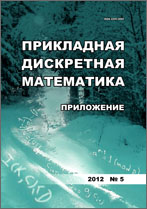|
This article is cited in 1 scientific paper (total in 1 paper)
Applied Theory of Coding and Automata
Periodic properties of a finite automaton generator
P. K. Obukhov, I. A. Pankratova
Tomsk State University
Abstract:
The periodic properties of a two-stage finite automaton generator $G=A_1\cdot A_2$ are studied, where $A_1=(\mathbb{F}_2^n,\mathbb{F}_2, g_1, f_1)$ (it is autonomous), $g_1:\mathbb{F}_2^n\rightarrow\mathbb{F}_2^n$, $f_1:\mathbb{F}_2^n\rightarrow\mathbb{F}_2$, $A_2 = (\mathbb{F}_2,\mathbb{F}_2^m,\mathbb{F}_2,g_2,f_2)$, $g_2:\mathbb{F}_2\times\mathbb{F}_2^m\rightarrow\mathbb{F}_2^m$, $f_2:\mathbb{F}_2\times\mathbb{F}_2^m\rightarrow\mathbb{F}_2$, $n,m\geq 1$. It is obtained that the maximum value of the generator period is $2^{n+m}$. Some necessary conditions for its achievement are formulated, namely: 1) the function $g_1$ is a full cycle substitution; 2) changing the initial state $x(1)$ or $y(1)$ does not affect the period of the generator; 3) function $f_1$ is not a constant; 4) at least one of the subfunctions $f_2(0,\cdot)$ and $f_2(1,\cdot)$ is not a constant; 5) the subfunctions $g_2(0,\cdot)$ and $g_2(1,\cdot)$ of the transition function $g_2$ are substitutions; 6) $y(2^ni+j)\neq y(2^nk+j)$ for all $i,k\in\{0,\ldots,2^m-1\}$, $i\neq k$, $j=1,\ldots,2^n$.
Keywords:
finite automaton generator, substitutions, periodic sequences.
Citation:
P. K. Obukhov, I. A. Pankratova, “Periodic properties of a finite automaton generator”, Prikl. Diskr. Mat. Suppl., 2023, no. 16, 141–143
Linking options:
https://www.mathnet.ru/eng/pdma630 https://www.mathnet.ru/eng/pdma/y2023/i16/p141
|

| Statistics & downloads: |
| Abstract page: | 65 | | Full-text PDF : | 19 | | References: | 18 |
|




 Contact us:
Contact us: Terms of Use
Terms of Use
 Registration to the website
Registration to the website Logotypes
Logotypes







 Citation in format
Citation in format 
